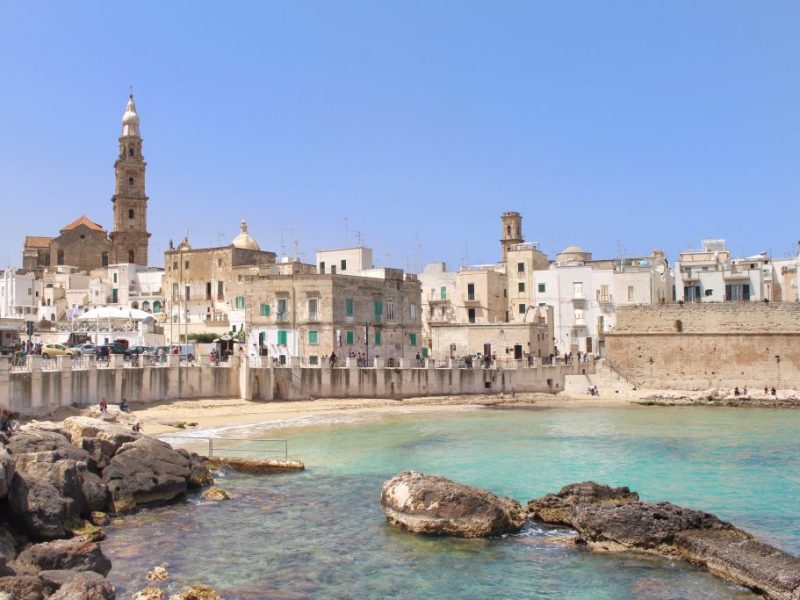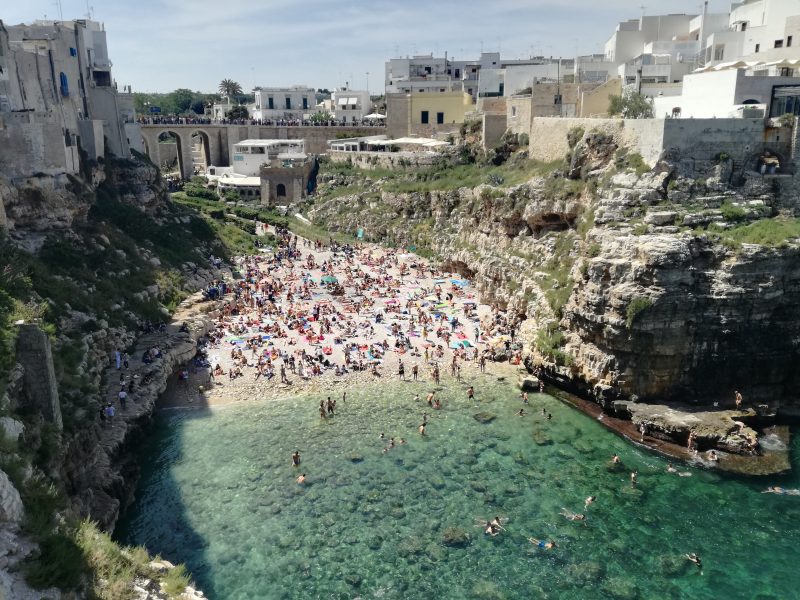The Borgo of Locorotondo
In Locorotondo, the voice of the “Scirocco” wind cavorts through the ancient stone lanes, joining the festivities at Largo Bellavista, the high point of the city, where the four winds of Salento meet and celebrate: the “Maestrale”, the “Ponente”, the dry and vivacious “Tramontana”, and that humid gift blowing in from Africa, the “Scirocco”, carrying the laughter of the children through the streets of the borgo as they open their arms and pretend they are flying, pushed along by the high wind.
“Locus Rotundus” follows the slow and sinuous line of the hills, its white-washed houses gleaming on the green fields of the Valle d’Itria. The historical center of Locorotondo is full of characteristic, poetic corners to discover, a concert of sounds floating over the lime-stone slab roofs, past flowering balconies of a thousand colors. The little streets are imperfect circles that revolve around the main church, passing the Piazza of Vittorio Emanuele, and the Municipal Villa, set like a balcony over the Valle d’Itria, which for over a hundred years has maintained the city’s secrets in the protective shade of its secular trees.
Locorotondo is made of folk tales passed along by word of mouth, chanted like lullabies, such as the traditional song “Diana”, composed here long ago and sung every August, at the festival of San Rocco. Locorotondo is an authentic borgo of ancient traditions, its identity supremely expressed through its cuisine in a bounty of genuine ingredients and delicate flavors: the perfect way to begin your discovery of this magical land.












































History
Locorotondo’s origins are woven together with the threads of myth and legend that began many centuries before the birth of Christ, perhaps even three thousand years before.
Archeological findings suggest that the territory was first inhabited by various nomadic groups, and later by tribes that settled at the base of the hills. The first written document attesting the presence of this borgo in the hills dates back to 1195, but it is highly probable that the village was already in existence at the end of the year 1000, when the Benedictine Monastery was constructed.
During the Medieval period, the little fiefdom was caught up in controversies and disputes of the reigning nobles of the day, and was passed from one dynastic family to another, among them the Carafa and the Orsini del Balzo families.
It was only in the 1500’s that the borgo began to thrive and expand, favored by an increase in the demographic population. Defensive walls were constructed and a castle was built, but these constructions only remained standing until 1800.
At the end of the 1700’s, Locorotondo was a vortex of revolutionary activity, caused by the struggle to create the foundation of the Roman “Repubblica”, and by the Bourbon royal movement “Partenopea”.
Chiesa di San Giorgio Martire, The Church of St. George the Martyr
The Church of San Giorgo is the main Church of Locorotondo and was constructed at the end of the 1700’s on the same site as two previous churches.
The Church of San Gorgio is in the very center of the borgo and all the streets of the borgo circle around its piazza. The façade is in Neoclassical style, embellished with a gable carved in relief depicting St. George and two dragons. Lower down, we find St. Peter and St. Paul. On the right side, small crosses are carved, which probably indicate where the first stones of the church were laid, as well as the remains of San Ruffino and San Vittorio.
The dome, or cupola, of the church was once covered with multicolored ceramic tiles, but it was damaged by lightening in 1841 and never restored.
The interior is in the Greek cross layout, characterized by an intriguing comingling of Neoclassical architectural elements and Renaissance and Baroque decorations.
On the left side of the church is the chapel of SS Sacramento, custodian of forty-two marvelous paintings of scenes from the Old and the New Testament.
The central altar is in Baroque style from the Neapolitan school. The Church of San Giorgio is full of prestigious paintings adorning the alters and the Sacristy, some of which by important Neapolitan masters.
The Orthodox Churches of Locorotondo
During the Middle Ages, a small Greek-Orthodox community lived in Locorotondo, and today, two remaining churches give testimony to that culture.
The Church of Madonna della Greca is the most ancient church in Locorotondo, dating back to 1480, when the Duke Orsini of Taranto made a visit to the borgo and commissioned its construction. Even though it has been remodeled several times, it has conserved its Medieval essence, in both the façade and the interior. The façade is without embellishments, adorned only by the central rose window and the two lateral statues of St. Peter and St. Paul, which were probably taken from the borgo’s original main church. Initially, the church must have been full of frescos, of which today remain only fine lines, with the figure of the baby Jesus still visible. The carved stone alter is exceptionally beautiful and symbolic.
The second church, dedicated to San Nicola, is nestled between private homes and is distinguished by the small central rose window adorning the façade. It was constructed over an ancient church dedicated to San Myra. A lime-stone slab roof protects an arched ceiling “a botte”, covered in frescos depicting scenes of the miracles of San Nicola, who is accompanied by angels playing rare musical instruments.
Once a month, the Orthodox community celebrates its sacred rites in these two churches.
“Le cummerse”, the cone shaped houses
The historical center of Locorotondo is particularly important because it is characterized by the
“cummerse”, traditional houses with coned roofs covered with “chiancarelle”, or lime-stone slabs, which are completely different from the typical architectural style of southern Italy. The “cummerse” are constructed with a technique similar to the one used to make stone walls and “trulli”, (the ancient stone dwellings of Puglia), the roofs left in stone, and the walls white-washed with lime-stone plaster.
Today, the importance of the “cummerse” is being reappraised, thanks to the project, “Sotto le cummerse”.
Trullo di Marziolla
Following the “vie dei Tratturi”, the ancient agricultural roads outside Locorotondo, you come to the “Trullo Marziolla”. This is not a typical “trullo”, such as the ones found all around Puglia, although it is surrounded by the usual ancient stone walls and verdant olive groves. The walls of this “trullo” are much thicker, and, carved in the architrave is the inscription of its construction date, only semi-legible, indicating sometime between 1559 and 1599, making it the oldest “trullo” in Puglia.
The “Trullo Marziolla” was built entirely with the technique “muro a secco”, which is an ancient stonemason’s technique that uses only stone on stone, with no filler or bonding element, carving and fitting the stones together so that the weight of the stones and the force of gravity progressively locks the stones together, making the structure veritably indestructible. The roof is in the typical cylindrical style, though more rustic. The “trullo” is made of two nucleus forms, one more ancient than the other, which successively became a central unit.
Il Locorotondo.
For most people, “Il Locorotondo” brings to mind a little village nestled in the hills of the Valle d’Itria, but wine experts and sommelier know better: it is one of the most famous DOP white wines in the region. It is a blend of Verdeca and Bianco d’Alessano grapes, cultivated between Locorotondo and Cisternino, sometimes enhanced by the addition of Malvasia, Bombino and Fiano grapes. In the past, this wine was used principally as a base for Vermouth, but recently it has become appreciated among wine lovers, thanks to more selective harvesting of the grapes and the improvements brought by the implementation of modern enological techniques, which have exalted the characteristics of the grape blend. The result is a product of optimum quality, a fresh, pleasant wine to enjoy soon after bottling.
The Festival of San Rocco
In the Medieval Age, Locorotondo was spared an epidemic of the Plague that brought the rest of the Valle d’Itria to its knees. Undoubtedly, it was the disinfectant qualities of the lime-stone plaster covering the houses that kept the epidemic away from Locorotondo, but the population saw it as a “grazia” or blessing, given by San Rocco, the patron saint of the sick and the plague-infected. Ever since, San Rocco has been the patron saint of the city. A church was built in his name, a wooden statue carved in his image, and every 16th of August the whole town celebrates him. The Festival of San Rocco is an authentic traditional festival, characterized a farm animal fair and also by the ancient song “Diana”, a military march that is played by the two local marching bands. At midnight on the 16th , a fireworks contest begins and the people look up in wonder, the white houses illuminated, reflecting the thousand flashing colors in the sky.
Do you know famous people of this borgo? Contact us!
The local cuisine of Locorotondo is characterized by essential, genuine ingredients, and simple dishes that are rich in convivial cheer.
There are two dishes that stand out in the culinary tradition of the borgo, the first because it has all the essential characteristics of country cooking in the region, and the second because it is a complete exception to the rule.
The symbolic dish of Locorotondo is “gnummarèdde suffuchète”, a dish made of tripe and lamb innards, which challenges skeptics, winning them over hands down. “Gnummarèdde” means “ball of wool” in dialect, and in fact the innards are enclosed in the tripe and then wrapped around and around with entrails, just like a ball of wool. “Gnummarèdde” is best cooked on the grill, even better over a the ardent coals of a barbeque, to be served hot and steaming.
The consumption of animal innards is a practice that goes back to the beginning of time. In Ancient Greece it was common practice to sacrifice animals to the Gods, after which they would be dismembered and roasted. The innards were eaten with gusto, while the rest of the carcass was left to burn as an offering to the deities.
The other aspect of “cucina povera” (simple country fare) of Locorotonda, is represented by “U triddu”, a dish consumed by the middle class, and that for centuries has accompanied all the important occasions, joyful or sad, of the inhabitants of the borgo.
“U triddu” is made from durum wheat flour, whole eggs and “pecorino sardo”, (a variation of sheep cheese). The ingredients are mixed until a soft, porous dough is obtained, which is then extended by a type of rolling pin, the “Jalonère”, rolling the dough into a thin sheet. The sheet of dough is left to dry and is then cut into imprecise rectangles, which are cooked in turkey broth and topped with grated cheese before serving.
“U triddu” is a nutritious, substantial dish, and so is a traditional feature in holidays like Christmas and Easter, but it also a symbol of condolence and sympathy in times of mourning. “U triddu” is still used today as “il conso”, a traditional practice in southern Italy: at the end of a funeral, friends bring the grieving relatives a meal which they all eat together, offering sustenance to begin anew after their loss.
“U triddu” was also administered to mothers who had just given birth, to help them gain strength, but tradition required that the broth be made of two pigeons, to be given by the God-mother of the newborn baby.

 Italiano
Italiano
 Deutsch
Deutsch



